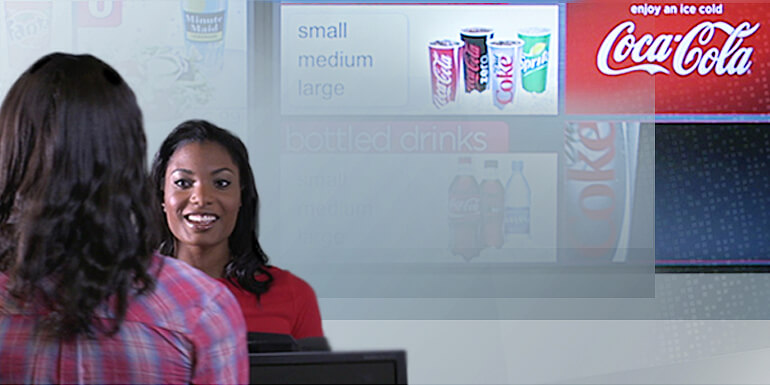
Digital Menu Boards: More Than Meets the Eye
Customize messages with motion graphics and targeted content

The digital era has allowed menu boards to evolve from a pure informational display to an integral part of a restaurant’s overall communication strategy. Used appropriately, digital menu boards (DMBs) provide an array of capabilities and benefits that can attract shopper attention, increase sales and improve the shopper experience.
Among other things, DMBs are customizable – allowing retailers and foodservice operators to choose technologies that best suit their individual needs – and can be optimized to apply key research learnings as appropriate across markets, channels and customers. The potential downside is clutter, so be aware that it can be no more beneficial to overload consumers with endless options than to provide them with too few choices and occasions.
Here are some DMB features and their benefits:
- Motion-graphic messages are attention grabbing (noticed 5-10 times more than static1)
- Flexibility and agility allow for swapping out day-part menus and promotional material, as well as quickly adjusting prices, specials and depleting inventory
- Integration with POS systems, inventory and third-party information sources facilitates “in the moment” knowledge
Operators have identified which of these are most important to them. Control of content tops the list at 68% followed by pricing flexibility (49%), lower costs to make changes (49%), increased sales of promotional items (38%), improved operational efficiency (38%) and higher check averages (21%).2
Benefits for consumers include decreased perceived wait times, easier ordering, better informed decisions, high-quality experience on the go, nutritional information and easy order verification.3
Effective Menu Board Fundamentals Still Apply
“Out with the old, in with the new” does not necessarily apply when it comes to DMBs, since the following tried and true principles4 associated with static menu boards are valid for newer platforms as well:
- Keep it simple – select a single relevant message and don’t detract from it
- Avoid redundancy/repetition and eliminate message clutter
- Show combos with different beverage options
- Use images and large, bold text
- Focus on a powerful key visual, and apply realistic and appetizing pictures
- Selectively employ unique fonts and treatments
- Emphasize “hero” brands
- Be transparent with pricing/up-charges
- Invite, don’t command
Learnings from research practices suggest that showing items as they are typically eaten (e.g. a sandwich next to a drink) satisfies consumers’ desire for “what you see is what you get,” increases appetite appeal and makes the meal complete.5 Additional insights from this research include5:
- Place pictures on the left and text on right, since image on left layout is more quickly and efficiently processed by the brain
- Create a “pop-out” effect with contrast
- Use brightness and color contrast to highlight items without cognitively taxing the brain
- Celebrate the curve (the brain loves curves and rounded edges)
- Videos can drive purchase, but can also add clutter and have the potential to be too long
- Take advantage of the “cathedral effect,” i.e. draw attention with images that “point up” and place important messaging at the top
- Use simple puzzles to engage, partially hiding well-recognized images to create simple puzzles the brain enjoys “solving”
Customize Messaging for Local Conditions
Using digital technology to customize messaging for local conditions and expectations can be beneficial. Emerging best practices include: tailoring content to the consumer “in the moment” and by day-part, day of week, season, local events/weather conditions and allowing local franchisees to customize.6 Regularly updating content is important so it stays fresh.
Similarly, how much movement to use may depend on the audience. Adults and young adults express differing responses – and expectations – regarding movement. Adults (25-54) express concerns about being overwhelmed with too much movement, whereas young adults (18-24) are much more receptive to motion and different moving elements. The opportunity exists to customize the level of motion for the local audience mix – e.g. region, restaurant type and individual restaurant.6
Industry Perspective Still Evolving
While appreciative of benefits such as printing cost savings, increased control/flexibility, improved consumer experience and better brand impression/look, operators also express some concerns about cost, logistics, fear of technology, supplier issues and the difficulty of attributing “hard financial ROI” to DMBs exclusively.6
Although further study will be useful to determine the right content mix for DMBs and frequency for refreshing it, the bottom line is not to skimp on design – since poor quality visuals may do more harm than good. Make content/visuals consistent with the brand’s existing look and feel, develop visuals with the native screen resolution and current software in mind and ensure content is easy to understand for all customers and does not assume prior experience.
Sources:
1. Digital Menu Boards Insights & Strategy
2. Top 12 Benefits of Digital Menu Boards (Infographic 2009)
3. Four Soft ROI Benefits of Digital Signage and Digital Menu Boards Insights & Strategy (2009)
4. Digital Menu Board (DMB) Research: Business Discovery” (Gongos, May-June, 2014)
5. “QSR Neuromarketing Beverage Merchandising and Messaging Study & Principles” (CCR, 2010)
6. Digital Menu Board (DMB) Research: Business Discovery” (Gongos, May-June, 2014)